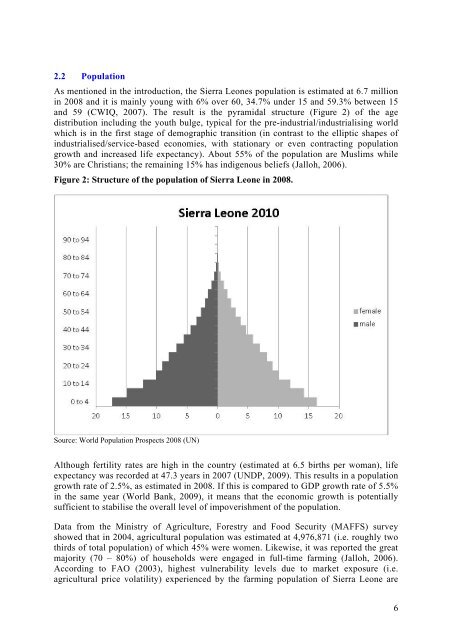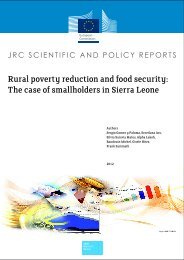The case of smallholders in Sierra Leone - agrilife - Europa
The case of smallholders in Sierra Leone - agrilife - Europa
The case of smallholders in Sierra Leone - agrilife - Europa
Create successful ePaper yourself
Turn your PDF publications into a flip-book with our unique Google optimized e-Paper software.
2.2 Population<br />
As mentioned <strong>in</strong> the <strong>in</strong>troduction, the <strong>Sierra</strong> <strong>Leone</strong>s population is estimated at 6.7 million<br />
<strong>in</strong> 2008 and it is ma<strong>in</strong>ly young with 6% over 60, 34.7% under 15 and 59.3% between 15<br />
and 59 (CWIQ, 2007). <strong>The</strong> result is the pyramidal structure (Figure 2) <strong>of</strong> the age<br />
distribution <strong>in</strong>clud<strong>in</strong>g the youth bulge, typical for the pre-<strong>in</strong>dustrial/<strong>in</strong>dustrialis<strong>in</strong>g world<br />
which is <strong>in</strong> the first stage <strong>of</strong> demographic transition (<strong>in</strong> contrast to the elliptic shapes <strong>of</strong><br />
<strong>in</strong>dustrialised/service-based economies, with stationary or even contract<strong>in</strong>g population<br />
growth and <strong>in</strong>creased life expectancy). About 55% <strong>of</strong> the population are Muslims while<br />
30% are Christians; the rema<strong>in</strong><strong>in</strong>g 15% has <strong>in</strong>digenous beliefs (Jalloh, 2006).<br />
Figure 2: Structure <strong>of</strong> the population <strong>of</strong> <strong>Sierra</strong> <strong>Leone</strong> <strong>in</strong> 2008.<br />
Source: World Population Prospects 2008 (UN)<br />
Although fertility rates are high <strong>in</strong> the country (estimated at 6.5 births per woman), life<br />
expectancy was recorded at 47.3 years <strong>in</strong> 2007 (UNDP, 2009). This results <strong>in</strong> a population<br />
growth rate <strong>of</strong> 2.5%, as estimated <strong>in</strong> 2008. If this is compared to GDP growth rate <strong>of</strong> 5.5%<br />
<strong>in</strong> the same year (World Bank, 2009), it means that the economic growth is potentially<br />
sufficient to stabilise the overall level <strong>of</strong> impoverishment <strong>of</strong> the population.<br />
Data from the M<strong>in</strong>istry <strong>of</strong> Agriculture, Forestry and Food Security (MAFFS) survey<br />
showed that <strong>in</strong> 2004, agricultural population was estimated at 4,976,871 (i.e. roughly two<br />
thirds <strong>of</strong> total population) <strong>of</strong> which 45% were women. Likewise, it was reported the great<br />
majority (70 – 80%) <strong>of</strong> households were engaged <strong>in</strong> full-time farm<strong>in</strong>g (Jalloh, 2006).<br />
Accord<strong>in</strong>g to FAO (2003), highest vulnerability levels due to market exposure (i.e.<br />
agricultural price volatility) experienced by the farm<strong>in</strong>g population <strong>of</strong> <strong>Sierra</strong> <strong>Leone</strong> are<br />
6
















